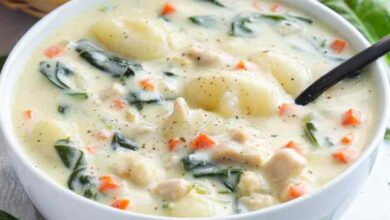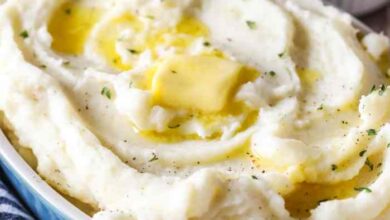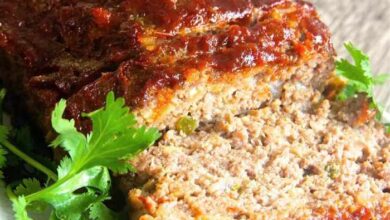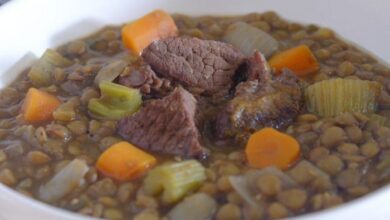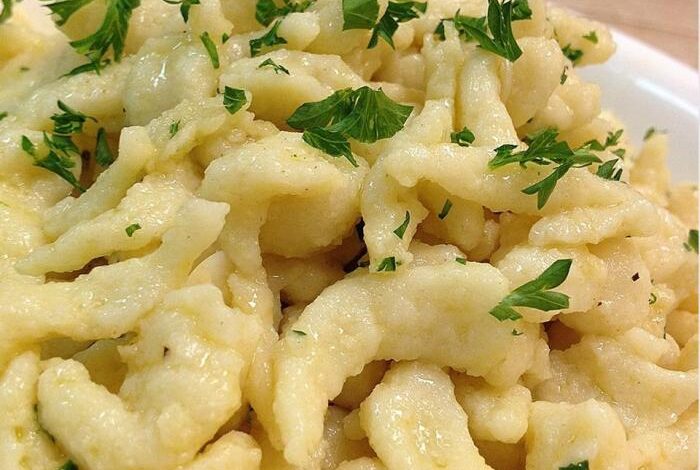
Spaetzle Sauerkraut and Sausage Casserole: A Comforting Classic
Spaetzle sauerkraut and sausage casserole is a dish that embodies the spirit of comfort food. It’s a harmonious blend of textures and flavors that transports you to a cozy kitchen, where the aroma of simmering sauerkraut and browned sausage fills the air.
The origin of this dish is rooted in the culinary traditions of Central Europe, where spaetzle, a type of German noodle, is a beloved staple.
The dish’s cultural significance lies in its ability to bring people together around a shared table. It’s a dish that’s often passed down through generations, with each family adding their own unique twist to the recipe. Whether you’re a seasoned cook or a culinary novice, spaetzle sauerkraut and sausage casserole is a dish that’s easy to prepare and sure to please even the most discerning palate.
Introduction to Spaetzle, Sauerkraut, and Sausage Casserole
This hearty and comforting casserole is a delicious fusion of flavors and textures, bringing together three iconic ingredients: spaetzle, sauerkraut, and sausage. While each ingredient has its own unique history and cultural significance, their combination in this dish creates a symphony of tastes that has captured the hearts and stomachs of many.
Origins and History of Spaetzle, Sauerkraut, and Sausage
Spaetzle, a type of German dumpling, has a rich history dating back to the Middle Ages. Its origins can be traced to the Swabia region of Germany, where it was traditionally made with simple ingredients like flour, eggs, and water.
Over time, spaetzle spread throughout Europe, becoming a staple in various cuisines. Sauerkraut, on the other hand, is a fermented cabbage dish that originated in China and was later introduced to Europe by the Mongols. Its popularity in Germany dates back to the 16th century, where it became a common food during times of scarcity.
Sausage, a versatile and widely consumed meat product, has been enjoyed for centuries across the globe. Its origins are uncertain, but evidence suggests that sausage-making practices existed in ancient times.
Cultural Significance of Spaetzle, Sauerkraut, and Sausage
These three ingredients hold significant cultural importance in various regions. Spaetzle is a beloved dish in Germany, Austria, and Switzerland, often served as a side dish or as part of a larger meal. Sauerkraut is a quintessential ingredient in German cuisine, often associated with traditional dishes like sauerbraten and pork knuckle.
Sausage, a versatile and widely consumed meat product, has a rich cultural history in many countries, with different regions developing their own unique varieties.
Flavor Profiles and Textures of Spaetzle, Sauerkraut, and Sausage Casserole
The spaetzle in this casserole provides a soft and chewy texture, contrasting beautifully with the tangy and slightly sour flavor of the sauerkraut. The sausage adds a savory and meaty element, while the combination of spices and herbs creates a complex and aromatic profile.
The casserole is typically baked until golden brown, resulting in a crispy top and a warm and comforting interior.
Ingredients and Variations
This hearty casserole is a wonderful blend of flavors and textures, with spaetzle providing a delightful chewiness, sauerkraut adding tanginess, and sausage contributing savory richness. While the classic recipe is a delight, there are numerous variations that cater to different dietary preferences and regional tastes.
Essential Ingredients
The foundation of this casserole lies in its core ingredients:
- Spaetzle:These soft egg noodles are the star of the show, providing a comforting texture and absorbing the flavors of the other ingredients.
- Sauerkraut:Fermented cabbage adds a tangy and slightly sour note, balancing the richness of the sausage and the creaminess of the sauce.
- Sausage:Traditionally, German-style bratwurst is used, but other types like Italian sausage or kielbasa can be substituted.
- Onion:Provides a sweet and savory base for the sauce.
- Butter:Adds richness and enhances the flavor of the sauce.
- Flour:Thickens the sauce, creating a creamy consistency.
- Milk or Cream:Adds moisture and creaminess to the sauce.
- Salt and Pepper:Seasoning to taste.
Variations and Substitutions
- Vegetarian:Omit the sausage and replace it with plant-based alternatives like seitan, tempeh, or mushrooms.
- Gluten-Free:Use gluten-free spaetzle or substitute it with another type of noodle, such as rice noodles or quinoa noodles.
- Dairy-Free:Use dairy-free butter and milk alternatives like almond milk or coconut milk.
Regional Variations
Regional variations often involve different sausage types and additional ingredients:
- Bavarian:Often features a smoked sausage like Nürnberger Bratwurst, and may include additional ingredients like caraway seeds or apples.
- Alsatian:Typically uses a pork and bacon sausage, and may include onions, apples, and juniper berries.
- Austrian:Often features a spicy sausage like Debrecziner, and may include paprika, caraway seeds, and a splash of white wine.
Cooking Techniques and Methods
This section delves into the specific techniques and methods for preparing the individual components of our spaetzle, sauerkraut, and sausage casserole. Understanding these methods will ensure a delicious and well-balanced dish.
Spaetzle Preparation
Spaetzle, the delightful German noodle, can be prepared using a variety of methods, each offering its own advantages and nuances.
- Spaetzle Maker:This traditional tool, a simple box with holes, allows for even, perfectly shaped spaetzle. The dough is pressed through the holes into boiling water, resulting in small, delicate noodles. The spaetzle maker offers a classic approach, ensuring consistent shape and size.
This spaetzle sauerkraut and sausage casserole is a hearty, comforting dish that reminds me of cozy evenings spent with family. It’s a bit like a German take on mac and cheese, but with a tangy twist from the sauerkraut. Speaking of twists, I recently tried a recipe for brooklyn girls penne arrabiata that really impressed me with its bold flavors.
It’s a perfect example of how a simple pasta dish can be elevated with the right ingredients. Now, back to the spaetzle casserole – it’s definitely a dish I’ll be making again soon, especially when the weather starts to get colder.
- Colander:This readily available kitchen tool provides a quick and easy alternative. The dough is pressed through the colander’s holes into boiling water, creating a similar effect to the spaetzle maker. This method is convenient for those without a specialized tool.
- Potato Ricer:A potato ricer, often used for mashing potatoes, can also be used to create spaetzle. The dough is pressed through the ricer’s holes into boiling water, resulting in slightly larger, irregular noodles. This method adds a rustic touch and can be particularly useful if you don’t have a spaetzle maker or colander.
Sausage Browning
Browning the sausage is a crucial step, adding depth of flavor and a crispy texture to the casserole.
- Skillet Method:The most common method involves browning the sausage in a skillet over medium heat. This allows for even browning and rendering of the fat. It is essential to break up the sausage as it cooks, ensuring that all surfaces are browned and the fat is released.
- Oven Method:For a hands-off approach, you can brown the sausage in the oven. Preheat the oven to 400°F (200°C) and spread the sausage on a baking sheet. Bake for 15-20 minutes, stirring occasionally, until browned and cooked through. This method is particularly useful for larger quantities of sausage.
Onion and Garlic Sauteing
Sautéing the onions and garlic adds sweetness and aromatic depth to the casserole.
- Skillet Method:Sauté the onions and garlic in a skillet over medium heat with a little oil or butter. The onions should be softened and translucent, and the garlic should be fragrant but not burnt.
Assembly and Baking
The magic of spaetzle, sauerkraut, and sausage casserole lies in its assembly. Layering the ingredients creates a symphony of flavors and textures, with each component contributing to the overall culinary masterpiece.
Layering the Casserole
The layering process is crucial for achieving a well-balanced casserole. The order of ingredients is as follows:
- Sausage:Begin by spreading a layer of cooked and crumbled sausage at the bottom of the baking dish. This provides a savory base and a source of protein.
- Sauerkraut:Next, layer the sauerkraut on top of the sausage. The tangy and slightly acidic sauerkraut balances the richness of the sausage and adds a touch of complexity to the dish.
- Spaetzle:Place a layer of freshly made spaetzle on top of the sauerkraut. The spaetzle absorbs the flavors of the sausage and sauerkraut, creating a delicious and satisfying main component.
- Broth or Sauce:Pour a flavorful broth or sauce over the spaetzle. This ensures that the casserole cooks evenly and develops a rich, creamy consistency.
- Cheese (Optional):For an extra layer of indulgence, sprinkle shredded cheese over the top. Choose a cheese that complements the other flavors, such as Gruyere, Emmental, or Fontina.
Broth or Sauce for Enhanced Flavor
A flavorful broth or sauce is essential for creating a cohesive and delicious casserole. It acts as a binder, bringing all the ingredients together and adding depth of flavor.
- Broth:A simple chicken or vegetable broth is a classic choice. You can also use a flavorful broth, such as beef or pork broth, to enhance the savory notes of the dish.
- Creamy Sauce:For a richer casserole, consider using a creamy sauce made with milk, cream, butter, and flour. You can also add herbs, spices, or mustard to enhance the flavor.
- Beer:For a unique twist, use a flavorful beer, such as a German Pilsner or a Czech Lager, to add a subtle malty note to the casserole.
Baking Temperatures and Times
Baking the casserole at the right temperature and for the right amount of time is crucial for achieving a perfectly cooked and golden dish.
- Temperature:Bake the casserole at 350°F (175°C) for 30-40 minutes, or until the spaetzle is golden brown and the cheese, if used, is melted and bubbly.
- Time:The baking time will vary depending on the size of the casserole dish and the amount of ingredients. It’s important to check the casserole after 30 minutes and continue baking until it’s heated through and the spaetzle is cooked to your liking.
Important Note:The baking time may need to be adjusted based on the type of casserole dish used. A glass dish may require a slightly shorter baking time compared to a metal dish.
Serving and Accompaniments
This hearty casserole is best served hot, straight from the oven. Its rich flavors and comforting textures are sure to satisfy even the most discerning palate. The dish can be enjoyed as a main course, or as a side dish alongside other lighter fare.
Serving Temperature and Presentation
The casserole should be served piping hot, allowing the cheese to melt and the flavors to meld. To ensure optimal presentation, use a large, oven-safe dish that will allow the casserole to be served directly from the oven to the table.
A sprinkle of fresh parsley or chives adds a touch of color and freshness to the dish.
Accompaniments
A variety of accompaniments can enhance the flavors of the casserole, creating a well-rounded meal.
Sometimes I crave hearty comfort food like spaetzle sauerkraut and sausage casserole, a dish that warms the soul with its savory flavors. But then there are days when I’m in the mood for something decadent and creamy, like Chantal’s New York Cheesecake.
It’s a classic for a reason – smooth, rich, and absolutely irresistible. But even after indulging in a slice of that cheesecake, I always find myself coming back to the comforting familiarity of my spaetzle sauerkraut and sausage casserole.
It’s a dish that never fails to satisfy.
Salads
A light and refreshing salad is a perfect complement to the rich casserole. Consider a simple green salad with vinaigrette dressing or a more substantial salad with grilled chicken or fish.
Sometimes I crave hearty comfort food like spaetzle sauerkraut and sausage casserole, but other times I’m in the mood for something lighter and more vibrant. When that happens, I turn to my trusty slow cooker for a batch of slow cooker pumpkin turkey chili.
It’s a great way to use up leftover turkey and the pumpkin adds a sweet and savory depth of flavor. But don’t get me wrong, I always come back to my spaetzle sauerkraut and sausage casserole – it’s a classic for a reason!
Side Dishes
Side dishes can add variety and texture to the meal. Roasted vegetables, such as asparagus, broccoli, or Brussels sprouts, are a healthy and delicious option. A side of mashed potatoes or rice can also be served.
Beverages
A glass of chilled white wine, such as Pinot Grigio or Sauvignon Blanc, pairs well with the flavors of the casserole. A crisp beer, such as a lager or pilsner, is another good option.
Variations in Serving Style
The casserole can be served in a variety of ways to suit different preferences and occasions. For a more casual gathering, individual portions can be served in ramekins or oven-safe bowls. For a larger family gathering, a large casserole dish can be used to serve the entire dish.
Flavor Profiles and Culinary Techniques
The beauty of spaetzle, sauerkraut, and sausage casserole lies in the harmonious interplay of its components, creating a symphony of flavors and textures that tantalize the palate. The dish showcases a delightful combination of savory, sweet, and acidic notes, each contributing to a well-balanced culinary experience.
Spice and Herb Enhancements
The judicious use of spices and herbs plays a crucial role in elevating the flavor profile of this casserole. Caraway seeds, often found in sauerkraut, impart a warm, earthy aroma that complements the richness of the sausage. A touch of nutmeg adds a subtle sweetness that balances the acidity of the sauerkraut.
Fresh herbs like parsley, thyme, or marjoram can be incorporated to add a layer of freshness and complexity.
Flavor Balance
Achieving a balance between savory, sweet, and acidic elements is key to creating a truly satisfying casserole. The savory notes come primarily from the sausage, while the sweetness is derived from the spaetzle and the natural sugars in the sauerkraut.
The acidity, provided by the sauerkraut, cuts through the richness of the other ingredients, preventing the dish from becoming overly heavy.
Nutritional Value and Health Considerations
Spaetzle sauerkraut and sausage casserole is a hearty and flavorful dish that can be a satisfying meal. However, it’s essential to be mindful of its nutritional content and potential health implications.
Nutritional Breakdown
This casserole is a good source of protein, carbohydrates, and some vitamins and minerals. The nutritional breakdown can vary depending on the specific ingredients used, but a typical serving might contain:
- Calories: 400-500
- Protein: 20-30 grams
- Carbohydrates: 40-50 grams
- Fat: 20-30 grams
- Fiber: 5-10 grams
- Sodium: 500-700 mg
The exact amounts will vary depending on the specific recipe and ingredients used.
Health Benefits and Risks, Spaetzle sauerkraut and sausage casserole
Potential Health Benefits
The casserole’s ingredients offer potential health benefits.
- Sausage:Provides protein and B vitamins. However, it’s important to choose lean sausage varieties to minimize saturated fat intake.
- Sauerkraut:A good source of probiotics, which can benefit gut health. It also contains vitamin C and fiber.
- Spaetzle:Offers carbohydrates for energy and some protein.
Potential Health Risks
While the casserole offers some nutritional benefits, it can also contribute to certain health risks if consumed frequently or in large portions.
- High in Fat and Sodium:The sausage, cheese, and butter can contribute to high fat and sodium content, which can increase the risk of heart disease and high blood pressure.
- Processed Meats:Some studies have linked processed meats, like sausage, to an increased risk of certain cancers.
Making the Casserole Healthier
Several adjustments can be made to make the casserole healthier:
- Use leaner meats:Opt for leaner sausage varieties or substitute ground turkey or chicken for the sausage.
- Reduce fat content:Use low-fat cheese or reduced-fat milk. You can also use less butter in the recipe.
- Increase vegetable content:Add additional vegetables, such as onions, peppers, or mushrooms, to the casserole for added nutrients and fiber.
- Serve with whole-grain sides:Pair the casserole with a whole-grain side dish, such as brown rice or quinoa, for added fiber and nutrients.
Cultural and Regional Influences
Spaetzle, sauerkraut, and sausage, the core ingredients of this comforting casserole, have deep roots in various cultures and regions, each contributing its unique flavor and tradition to the dish. Exploring their origins and regional variations reveals a rich tapestry of culinary history and cultural significance.
Origins and Cultural Significance
Spaetzle, a type of German dumpling, has a long history dating back to the Middle Ages. It is believed to have originated in the Swabia region of Germany, where it was a staple food for farmers and peasants. The dish’s simplicity and versatility made it a popular choice for families across various social classes.
Sauerkraut, fermented cabbage, is another staple in German cuisine, originating in the 16th century. Its origins can be traced back to the northern regions of Germany, where the preservation of cabbage through fermentation was a crucial technique for ensuring a reliable food source during the winter months.
Sausage, a versatile and flavorful ingredient, has a rich history spanning across numerous cultures. In Germany, sausage varieties like bratwurst, weisswurst, and karreewurst are popular and often incorporated into traditional dishes.
Regional Variations in Recipe and Preparation
The spaetzle sauerkraut and sausage casserole, while rooted in German culinary traditions, exhibits variations across different regions. For instance, in the Swabia region of Germany, the casserole often features a combination of spaetzle, sauerkraut, and a type of pork sausage called “Mettwurst.” In other regions, the casserole might include different sausage varieties, such as bratwurst or weisswurst, reflecting the local culinary preferences.
Cultural Significance in Various Communities
The spaetzle sauerkraut and sausage casserole holds a special place in the hearts of many communities, particularly in Germany and regions with strong German influences. In many households, the dish is considered a comfort food, evoking memories of family gatherings, holidays, and cherished traditions.
The casserole’s popularity extends beyond Germany, with variations found in other European countries, such as Austria, Switzerland, and France. In these regions, the dish has often been adapted to incorporate local ingredients and culinary styles.
Historical and Culinary Significance: Spaetzle Sauerkraut And Sausage Casserole
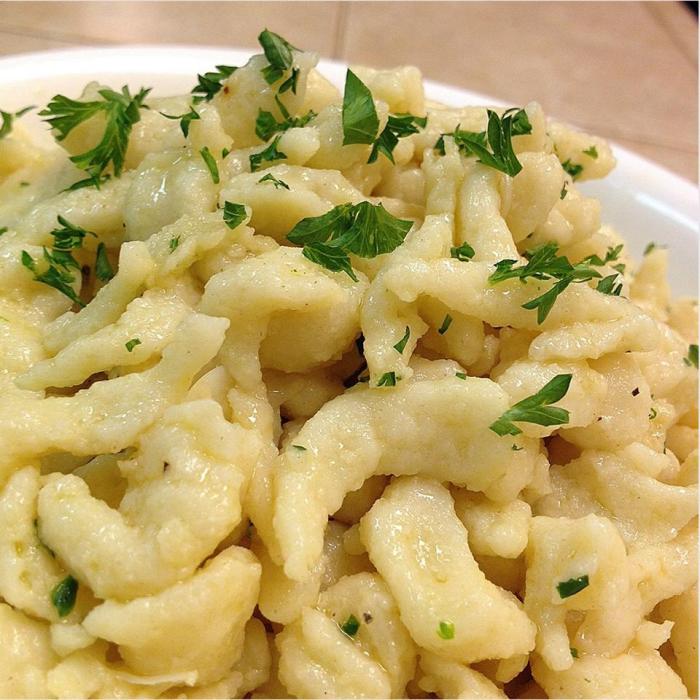
The spaetzle sauerkraut and sausage casserole, while a modern dish, boasts a rich history rooted in the culinary traditions of Europe. Its origins can be traced back to the individual components of the dish, each with its own unique story and evolution.The origins of the casserole itself, as a dish combining these ingredients, are more recent, likely emerging in the 20th century.
This is a period when the concept of the casserole, a convenient and hearty one-pot meal, gained popularity in Western cuisine.
The Influence of German and Austrian Cuisine
The spaetzle sauerkraut and sausage casserole is a testament to the influence of German and Austrian culinary traditions. Spaetzle, a type of soft egg noodle, is a staple in both cuisines, with its origins dating back to the Middle Ages.
Sauerkraut, fermented cabbage, is another key ingredient, deeply ingrained in German cuisine. It is believed to have been introduced to Germany by the Romans, who used it as a way to preserve cabbage during the winter months. The sausage component of the casserole, often a bratwurst or frankfurter, also reflects the influence of German and Austrian cuisine.
These sausages have been a part of German culinary tradition for centuries, with their origins tracing back to the Middle Ages.
The Role of the Casserole in Culinary History
The rise of the casserole in the 20th century reflects a shift in culinary trends towards convenience and practicality. As more women entered the workforce, the need for quick and easy meals increased. The casserole, with its ability to combine various ingredients into a single dish, offered a solution to this need.
It became a staple in American kitchens, particularly during the post-war era, and its popularity continues to this day.
The Evolution of the Dish and Its Adaptations Over Time
The spaetzle sauerkraut and sausage casserole has evolved over time, with variations arising from different regions and culinary preferences. Some variations might include the addition of other vegetables, such as onions, peppers, or mushrooms. Others might feature different types of sausage, such as kielbasa or Italian sausage.
The use of different cheeses, such as cheddar or Swiss, can also be seen in various adaptations of the dish. Additionally, some variations might call for the use of beer or broth in the sauce, adding another layer of complexity to the flavor profile.
Modern Interpretations and Innovations
The classic spaetzle, sauerkraut, and sausage casserole, while beloved for its comforting flavors and hearty nature, has also become a canvas for culinary creativity. Modern chefs and home cooks alike are reinterpreting this dish, exploring new flavor combinations, textures, and presentations, all while retaining the essence of the original.
Modern Culinary Techniques and Ingredients
The use of modern culinary techniques has significantly influenced the evolution of this casserole. Chefs are experimenting with innovative cooking methods, such as sous vide cooking for the sausage, which ensures even cooking and tender results. The use of molecular gastronomy techniques, like spherification, has also been incorporated, allowing for unique textural elements within the casserole.
For instance, spherified sauerkraut, with its burst of flavor and contrasting texture, adds a playful element to the dish. Furthermore, the inclusion of unexpected ingredients has become a defining characteristic of modern interpretations. The addition of artisanal cheeses, like smoked gouda or a sharp cheddar, enhances the richness and complexity of the casserole.
Exotic spices, such as smoked paprika or a touch of cumin, introduce intriguing notes that complement the traditional flavors.

